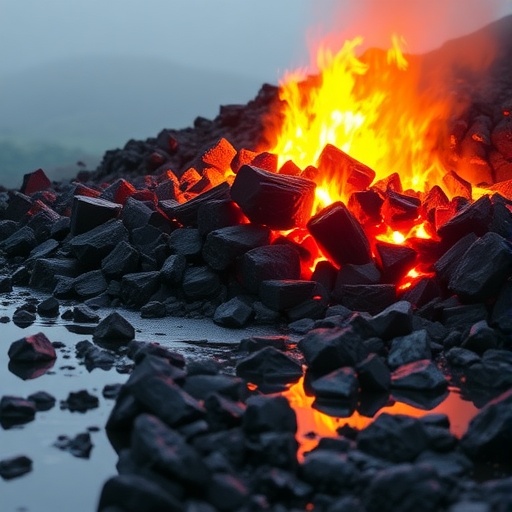In the intricate world of mining and energy production, managing residual resources often leads to unforeseen challenges, particularly when dealing with coal. Recent studies have highlighted the unique combustion behavior of weathered, water-saturated coal, which reveals critical insights into the ongoing environmental and safety dilemmas faced in energy extraction sectors. A pivotal study examining this phenomenon was conducted by Niu, Zhu, and Sun. Their research, published in Natural Resources Research, focuses on the combustion characteristics of coal left in goafs—regions where mineral extraction has already occurred.
Understanding the combustion behavior of coal in an oxygen-poor environment is increasingly relevant in the context of sustainable energy practices. As extraction methods evolve and places like goafs become more common due to depletion of accessible resources, the need for insights into residual coal combustion has taken center stage. Specifically, this research dives into how weathering processes, alongside moisture saturation, modify the thermal properties of coal, impacting its energy release dynamics.
The study is particularly focused on scenarios where water-saturation is prevalent, specifically addressing the unique challenges posed by an oxygen-poor atmosphere typically found within goafs. Oxygen enrichment is crucial for the combustion process, and the lack thereof significantly alters burning efficiency, fire intensity, and emission profiles. As temperatures rise, the conditions in goafs can foster combustion, but how does water saturation play into this complex chemical equation? This research tackles just that.
A key finding of their study is the discovery that weathered coal exhibits markedly different combustion characteristics compared to its unweathered counterparts. As coal weathers, physical and chemical properties change significantly, which can result in a decrease in calorific value, changes in structural integrity, and increased ash content. Under saturated conditions, these changes are amplified, potentially altering the way coal burns and the resultant heat produced during combustion. This understanding helps inform mining safety protocols and resource recovery strategies while minimizing fire hazards—a pressing concern for miners and energy producers alike.
Utilizing innovative experimentation techniques, the researchers constructed a series of controlled environments to mimic the conditions found in typical goaf settings. By meticulously measuring variables such as temperature, moisture content, and the rate of oxygen diffusion, the researchers were able to chart the combustion behavior of saturated, weathered coal. This experimentation yielded significant insights into optimal safety margins and operational thresholds that mining professionals should consider to prevent thermal disasters.
Particularly alarming was the quantification of thermal disaster risks associated with poorly managed coal deposits. Many mines operate under pressures to minimize shutdowns and downtime, often overlooking the significant risks that come from leaving weathered coal vulnerable. With data suggesting that improperly managed coal can lead to unexpected combustion events, this research acts as a clarion call for stricter oversight and improved management practices within the coal industry.
The implications of this study extend beyond immediate mining practices. With concerns around global warming and the urgent need for transitioning to cleaner energy, the way forward often involves dealing with legacy fossil fuel sites. Understanding how residual coal behaves can inform broader environmental policies and remediation efforts. As such, the findings outlined in this research suggest that proactive measures must be taken, not just in terms of immediate mining operations, but also in addressing broader environmental consequences.
The thermal behavior of coal under different environmental circumstances is a complex puzzle that also involves examining interactions with surrounding materials and gases. In the goaf environment, the interplay of coal, minerals, and moisture can create conditions that may accelerate or inhibit combustion. Therefore, this study highlights the importance of a holistic approach to understanding combustion phenomena, integrating geological, hydrological, and chemical factors.
Another fascinating outcome of this work is the perspective it lends on safety and incident preparedness within the mining sector. By quantifying the conditions that lead to thermal incidents, strategies can be developed to mitigate risks. The ability to predict when and where combustion might occur, based on the saturation levels of coal bodies and environmental conditions, could prove invaluable to operational safety protocols.
Additionally, the research lays groundwork for future studies, opening up avenues for exploring more sustainable practices in fossil fuel management. The findings could inspire innovations in how we handle legacy coal resources, emphasizing the importance for the mining industry to adopt safer, more efficient operational methodologies. The notion of coupling extraction with responsible environmental stewardship is beginning to gain traction, and this research exemplifies how scientific inquiry can pave the way forward.
To inform policy decision-making and set industry standards, it is crucial that data from studies like this is disseminated widely across sectors impacted by coal combustion dynamics. Not only does this research bring forth invaluable insights, but it also prompts questions about how such findings could influence international standards and regulations regarding energy extraction.
In conclusion, the research by Niu, Zhu, and Sun serves as an essential contribution to our understanding of coal combustion in complex environments. Their findings underscore the interplay of various physical factors in influencing thermal behavior, highlighting the need for vigilant safety considerations, and urging a re-evaluation of how the coal industry approaches resource management. The implications of their work could resonate through mining practices and environmental policies for years to come, galvanizing a shift toward a more responsible and informed approach to fossil fuel utilization.
Subject of Research: The combustion behavior of weathered, water-saturated coal in oxygen-poor environments.
Article Title: Combustion Behavior and Thermal Disaster Quantification of Weathered Water-Saturated Coal in an Oxygen-Poor Environment of Goaf.
Article References:
Niu, Hy., Zhu, Hl., Sun, Qq. et al. Combustion Behavior and Thermal Disaster Quantification of Weathered Water-Saturated Coal in an Oxygen-Poor Environment of Goaf. Nat Resour Res (2025). https://doi.org/10.1007/s11053-025-10556-0
Image Credits: AI Generated
DOI: 10.1007/s11053-025-10556-0
Keywords: combustion behavior, weathered coal, water-saturated coal, thermal disaster, mining safety, oxygen-poor environment, goaf, fossil fuel management.




